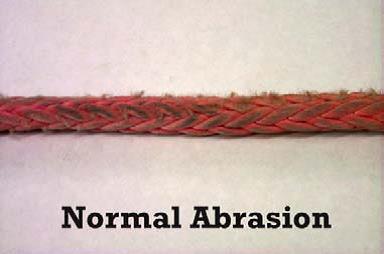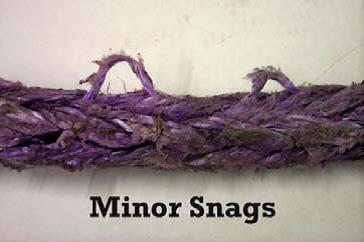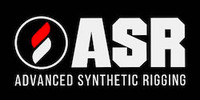Synthetic Winch Rope Info and Usage
What are the benefits of ASR synthetic HMPE Winch Lines over steel Winch Lines?
We at ASR have been huge proponents of the shift from Steel Cable/Wire to Synthetic Line since we stood up as a business in 2011. Although not perfect for all applications, HMPE synthetic lines are superior to steel cable in nearly all winching applications, from strength to handling characteristics and ease of use. HMPE is not a new product per se, but industry often takes a long time to transition to new technologies, and when it comes to the use of synthetic line, industry is now starting to make the transition - and if you are operating a winch with a steel cable, we encourage you to look at the many very significant benefits of HMPE winch lines and seriously consider switching over. You'll be glad you did! ASR HMPE Winch Lines come with the following benefits:
- Our HMPE Winch Lines exhibit little to no 'whip back' if the rope breaks, because HMPE is extremely light and has very little kinetic energy.
- Our HMPE Winch Lines are so light they float. Steel sinks.
- Our HMPE Winch Lines are compact and easy to handle, even in adverse conditions.
- Our HMPE Winch Lines cannot develop wire 'spurs', fish hooks & kinks that can develop in steel cable.
- Our HMPE Winch Lines are relatively easy to repair in the field.



What is Normal Wear and What Isn’t?
It is normal for a Synthetic Winch Line to develop some wear after regular use. Some wear is acceptable, but excessive wear or outright damage can cause a loss in strength of your Winch Line, ultimately resulting in failure. This set of guidelines is intended to help you determine what is considered to be normal wear, and when you need to consider removing a Winch Line from service.
Normal Wear
Normal wear consists of “light fuzzing” of the outer strands of rope. Some discoloration is normal and acceptable.
Moderate to Excessive Wear
Moderate to excessive wear consists of heavy fuzzing, pulled strands, cut strands, stiff/melted sections, and localized bunching of strands. These conditions should be flagged during regular inspection of your winchline, and damaged sections should be removed and respliced, or the full Winch Line should be replaced.
Moderate or excessive wear reduces the working strength of your Winch Line. Until the damage is repaired or the line is replaced, limitations on loading should be implemented commensurate to the level of damage the rope has sustained.
How Do I Repair A Damaged Synthetic Winchline?
Depending on the particular situation, synthetic Winch Lines can sometimes be repaired. For specific questions about repairing your Winch Line or performing any splices on your Winch Line, we suggest you contact ASR directly at info@go-asr.com.
"Why Did My Winch Line Fail?" How To Avoid Asking This Question.
With proper care and usage, winch lines made of synthetic rope should not fail during use, and will provide many years of successful, safe, and reliable performance. That being said, there are several common errors in installation or use that in many instances can - and have - caused unexpected failures. Be aware of the below issues in order to avoid these errors:
- Incorrect Wrap Direction - Winch Lines should generally feed off the bottom of the winch drum, and extend straight through the fairlead. Line feeding off the top of the winch drum may experience excessive wear or damage.
- Unintentional Abrasion - Use care when operating Winch Lines in conditions where they may come into contact with trail obstacles that are sharp or abrasive; utilize abrasion protection sleeving as needed or reconfigure your setup to eliminate sharp/abrasive contact hazards.
- Worn Rope - As with any tool, Winch Lines will eventually wear out over time. Regularly inspect your Winch Line for wear or damage and replace as necessary. Keep your Winch Line clean in order to prolong it's life! Dirt that works it's way into the central load-bearing fibers can act as an abrasive agent that can degrade rope strength.
- Shock Loading - Winch Lines should never be used as a yank strap. Shock loading can damage the fibers of any synthetic line, especially fibers made of materials like HMPE that have minimal elastic properties. Shock loading leads to friction between internal fibers as they move quickly past each other, and this friction creates heat which affects the strength of the fibers and the Winch Line assembly.
- Incorrect Rigging - Do not connect the hook back over the winchline. Always use the appropriate tree saver straps, shackles, pulley blocks, etc. when setting up a winch pull.
- Overloading - Know the Minimum Tensile Strength (MTS, or 'minimum breaking strength') rating for your Winch Line and all other rigging components that carry a load. There are many ways to estimate the load that a Winch Line is likely to experience (including variances due to vehicle weight/loading and terrain conditions) when recovering a vehicle, we strongly recommend using the Safe-Xtract Vehicle Recovery App - it's total resistance calculator is highly accurate and breaks down the loading for each component. Professional training is also highly recommended, we strongly recommend considering an International 4 Wheel Drive Trainers Association-certified trainer. Also avoid learning exclusively via YouTube, many of the people who post videos there are unaware of many of the more subtle dangers associated with use of synthetic line.
Synthetic HMPE Winch Rope to Steel Cable Comparison
| Diameter | Synthetic Weight | Steel Weight | Synthetic Strength (MBL) | Steel Strength (MBL) |
|---|---|---|---|---|
| 5/16" | 2.5 lbs/100' | 17.3 lbs/100' | 11,700 lbs | 9,800 lbs |
| 3/8" | 3.7 lbs/100' | 24.3 lbs/100' | 17,500 lbs | 14,400 lbs |
| 7/16" | 4.2 lbs/100' | 27.6 lbs/100' | 21,000 lbs | 17,600 lbs |
